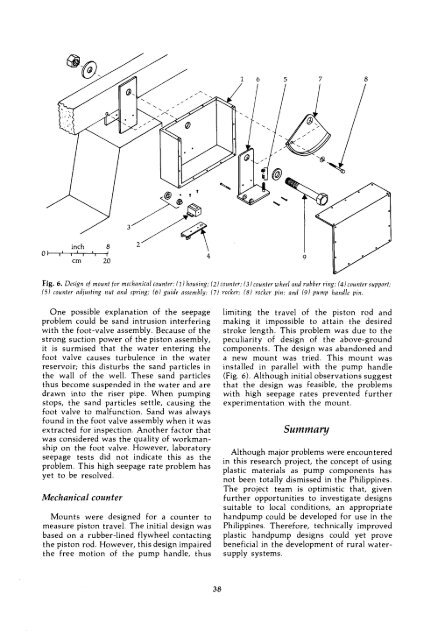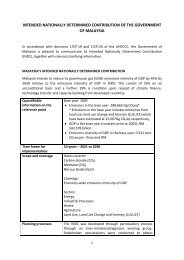RP-01638
RP-01638
RP-01638
Create successful ePaper yourself
Turn your PDF publications into a flip-book with our unique Google optimized e-Paper software.
Fig. 6. Design of mount for mechanical counter: (1) housing; (2) counter; (3) counter wheel and rubber ring; (4) cou nter support;<br />
(5) counter adjusting nul and spring; (6) guide assembly; (7) rocker; (8) rocker pin; and (9) pump handle pin.<br />
One possible explanation of the seepage<br />
problem could be sand intrusion interfering<br />
with the foot-valve assembly. Because of the<br />
strong suction power of the piston assembly,<br />
it is surmised that the water entering the<br />
foot valve causes turbulence in the water<br />
reservoir; this disturbs the sand particles in<br />
the wall of the well. These sand particles<br />
thus become suspended in the water and are<br />
drawn into the riser pipe. When pumping<br />
stops, the sand particles settle, causing the<br />
foot valve to malfunction. Sand was always<br />
found in the foot valve assembly when it was<br />
extracted for inspection. Another factor that<br />
was considered was the quality of workmanship<br />
on the foot valve. However, laboratory<br />
seepage tests did not indicate this as the<br />
problem. This high seepage rate problem has<br />
yet to be resolved.<br />
Mechanical counter<br />
Mounts were designed for a counter to<br />
measure piston travel. The initial design was<br />
based on a rubber-lined flywheel contacting<br />
the piston rod. However, this design impaired<br />
the free motion of the pump handle, thus<br />
limiting the travel of the piston rod and<br />
making it impossible to attain the desired<br />
stroke length. This problem was due to the<br />
peculiarity of design of the above-ground<br />
components. The design was abandoned and<br />
a new mount was tried. This mount was<br />
installed in parallel with the pump handle<br />
(Fig. 6). Although initial observations suggest<br />
that the design was feasible, the problems<br />
with high seepage rates prevented further<br />
experimentation with the mount.<br />
Summary<br />
Although major problems were encountered<br />
in this research project, the concept of using<br />
plastic materials as pump components has<br />
not been totally dismissed in the Philippines.<br />
The project team is optimistic that, given<br />
further opportunities to investigate designs<br />
suitable to local conditions, an appropriate<br />
handpump could be developed for use in the<br />
Philippines. Therefore, technically improved<br />
plastic handpump designs could yet proue<br />
beneficial in the development of rural watersupply<br />
systems.<br />
38



